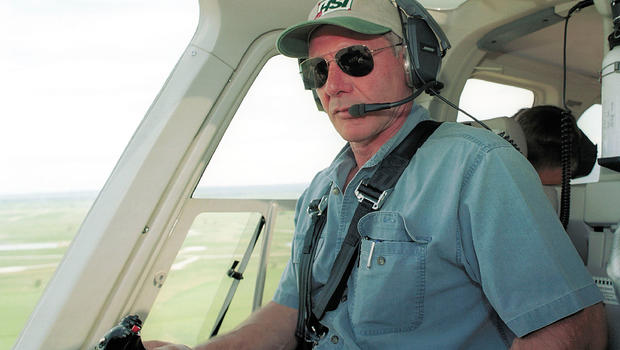Pretty
interesting! He's got a straightforward style, and lets you know right away whether he thinks the question is worth answering. While researching my helicopter book The God Machine, I
thought it would be good to get a high-profile user's view of the
machines, which are expensive to buy and operate. Ford is among a few thousand private owners who can afford it. (Photo, CBS News)
It took six months of back-and-forthing with his executive assistant at HF Productions, but in time we scheduled a half-hour talk. Ford was running early that morning so he called my cellphone to change the time, leaving a voicemail message, which (of course!) I saved.
The
subject was strictly helicopters; nary a movie in sight. He talked
about his training, his checkride in a Bell, and what it was like to
fly out of the notoriously challenging 60th Street Heliport in Manhattan. “Now it's shut down and that’s a good thing,” he said, comparing it to
flying in and out of a box with one open side. “When you came out,
you were facing an unknown wind, but the wind was usually along the
East River, out of the south to the north. It usually needed an
immediate pedal turn upon lifting up.”
Being
a superstar, while flying cross country, did he feel he could land
his Bell 407 just about any vacant field where it would fit, such as
near a roadside diner? No, he said, “I don’t do unplanned
back-lot landings, because I don’t know the municipal attitude.
They all have to have a say in helicopter landings. Plus, I’m getting fuel along the way so I’m stopping
at airports.”
I
asked him about his favorite times in a helicopter, “Probably
mountain flying in Wyoming,” he replied, referring to his volunteer
work around Jackson Hole. “One of the more critical flying tasks
was helping the mountain rangers pick up their winter stashes of
equipment. Density altitude is a factor, because of the height, and
also it’s warm by then. It’s pretty technical flying. You get a
couple of big guys in there, each 200 lb, and 250 lb of gear. …
This is just above the tree line. So it’s a matter of beoing able
to pick it up and drop it over a convenient edge – you have to fly
down before you can fly up, that kind of situation. Yes, that means
setting down pretty close to a dropoff.”
He
also enjoyed flying a tiltrotor at the Bell factory. “It's an
incredible machine – you tilt the nacelles over and you take off
like a drag racer.”
Emergency
procedures? He estimated that he'd done 200 “full down”
autorotation practices, with a freewheeling main rotor, and the machine gliding all the way to the ground. “I go to the
Bell school once or twice a year and they really train you in
emergency procedures,” he said. “They’ll have you do
twenty-five autorotations in a day.”
During practice in Southern California in 1999 the helicopter he was
flying with an instructor hit hard and turned over in a dry riverbed. “We were in a
[Bell] 206 at the bottom of autorotation [anticipating only doing an
autorotation to power recovery] but when we rolled the power in,
there was no response. It kept going down. This area is a helicopter
practice area but it has coarse sand, and there are a lot of snags.”
I
mentioned that some helicopter pilots never do any autorotation
practices all the way to the ground, because their schools consider
it too dangerous. “Well,” he said in a voice that sounded just
like Han Solo's, “assuming engines won’t ever quit, that’s not
a good idea.”
“There’s
all kind of helicopter traps out there – you’ve got to stay
alert.”

